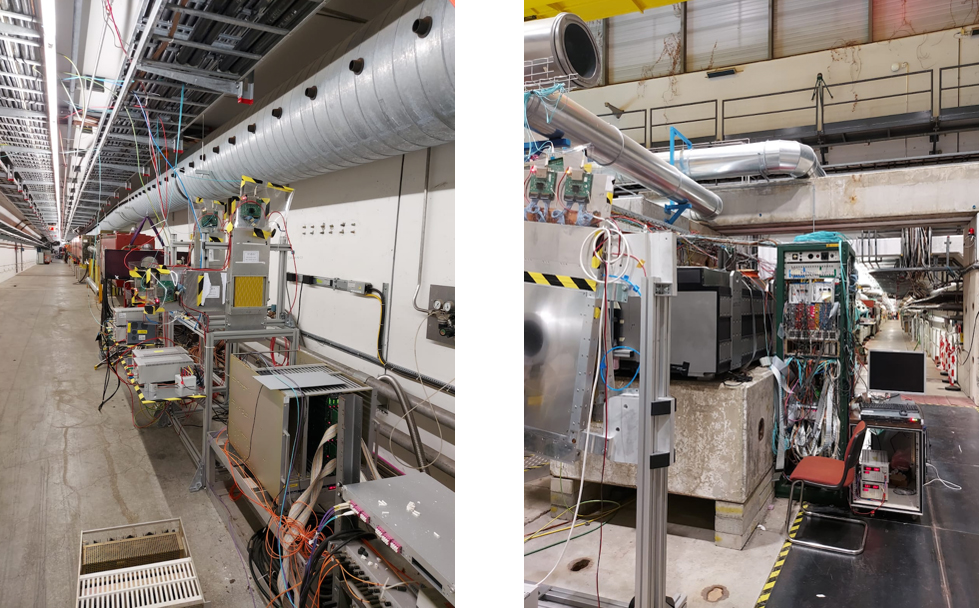Search for dark matter continues
News, 30 May 2022
In 2016, CERN approved and adopted for implementation the programme on searching for light dark matter at extracted secondary beams of the SPS accelerator, named as the NA64 experiment. The JINR group, taking part in drafting the proposal and physics motivation of the experiment, is responsible for the development and construction of coordinate detectors based on thin-walled straw tubes.
In the 2016-2018 runs, a search for a signal of the production and decay of the dark photon A’ and light dark matter was carried out at the CERN SPS electron beam. In total, ~ 4 · 1011 events were collected. In 2017-2018, the runs were also partially aimed at searching for a hypothetical 16.7 MeV boson. Its existence could explain the result of the anomalous production of e+e– pairs observed in the excited 8Be* nucleus decays obtained in the ATOMKI experiment. 8.4 · 1010 events were collected. The obtained data allowed significant increase of the limits on the probability of its production, complementing the results of other research groups.
 NA64 facility at M2 muon channel of SPS accelerator in CERN
NA64 facility at M2 muon channel of SPS accelerator in CERN
According to the results of 2019, CERN Director-General noted the NA64 experiment as one of the most interesting and scientifically promising projects being implemented at the Laboratory. In 2020, according to the CERN Directorate decision, the experiment obtained a permanent allocated place at the SPS secondary electron channel, PPE114 (H4B). Also, the research programme was expanded by constructing a setup and taking data with muon beams. This could contribute to resolving the (g-2)μ anomaly.
During CERN’s accelerators shutdown in 2020-2021, new detectors were constructed for operating at both electron and muon beams of the SPS: the SRD detector, a target tungsten calorimeter, electromagnetic and hadron calorimeters, veto calorimeters and a zero-degree calorimeter, and new tracking detectors made of large-area straw tubes. This upgrade was supported by the RF earmarked grant and JINR.
In 2021, after CERN started up its accelerators, the NA64 experiment was continued,
7 · 1010 events were registered at the electron beam despite the unstable operation of the accelerator after a long shutdown. From October 28 to November 18, a test run was performed at the SPS muon beam. During the run, the JINR group commissioned new large straw detector stations operating together with hadron calorimeters. The analysis of the obtained results has shown that for effective operation of the setup, its tracking system, based on Micromegas and GEM detectors, should be supplied with several detector stations of a larger effective size. They should be placed on a base about 100 meters from the input into the setup channel to its target. For implementing this, straw detectors with an operating area of 20x20cm2 made for operation at the electron beam were offered. In April, the JINR group prepared the gas and fiber-optic infrastructure required for the implementation of this proposal, as well as a power supply system, installed and implemented additional four straw stations to the setup DAQ.
On 16 May, a three-week NA64 run at the muon beam was completed. There were some difficulties with the SPS magnet system. While dealing with them, the collaboration lost more than half of data taking time, and it had to change the research programme. Nevertheless, the run was considered successful. ~4 · 1010 events were collected, which is about 80% of the planned statistics. The setup operated stably, the upgraded tracking system based on Dubna straw detectors allowed solving previously identified problems, controlling the beam structure and optimizing the trigger.
In the second half of June, a ten-week NA64 run is planned at the electron beam. Data taking on the search for light dark matter in the invisible mode of the dark photon A’ decay will be continued. The international team of the collaboration, representing the Americas, EU countries, leading institutes and universities of Russia, Belarus and JINR, is actively engaged in processing the data taken and preparing for the upcoming run.